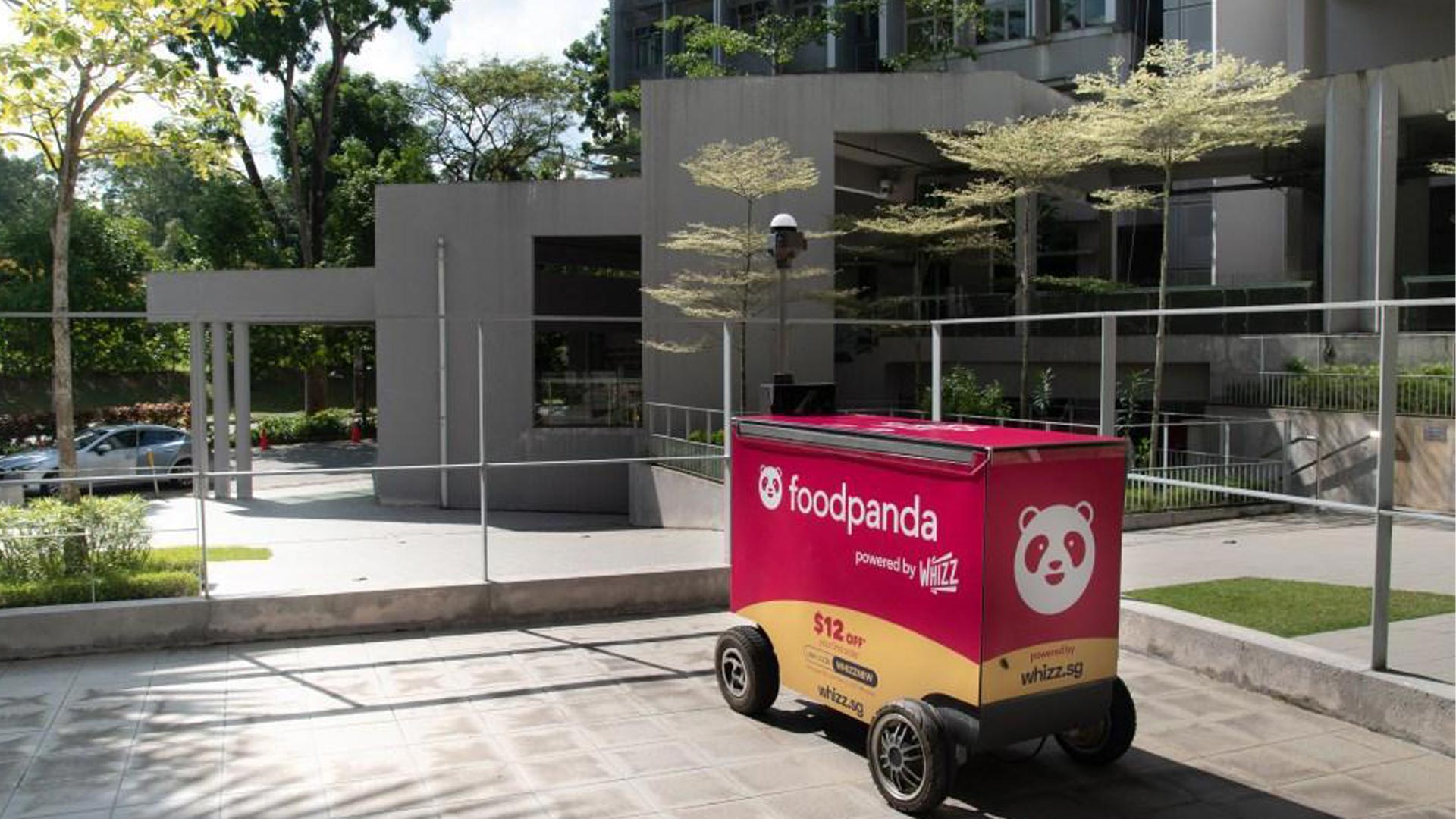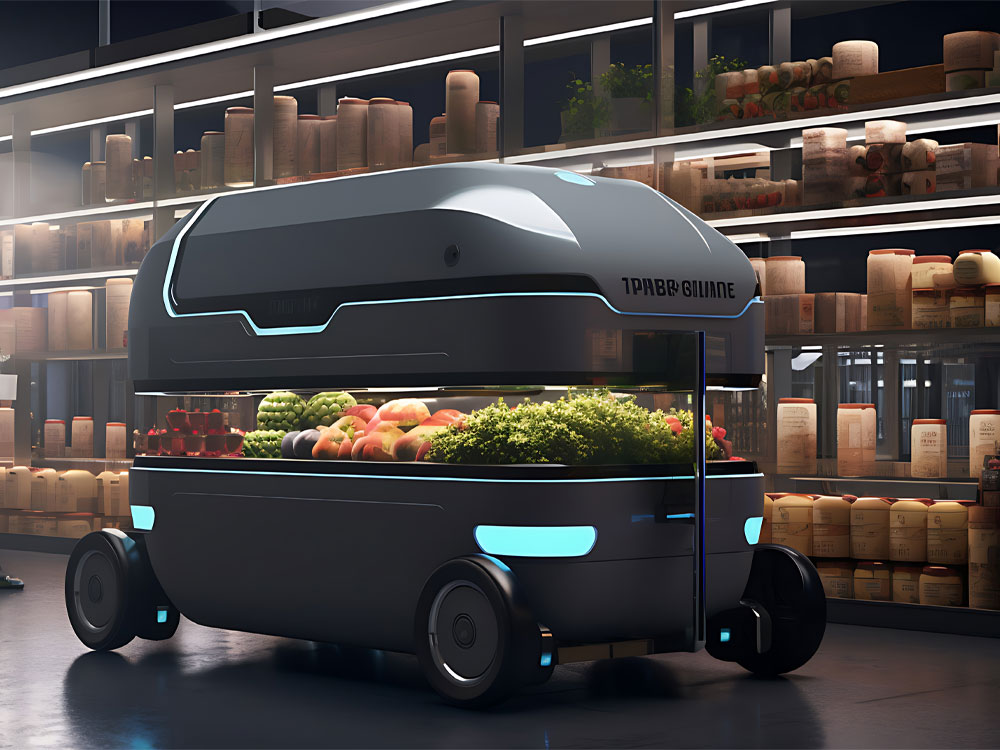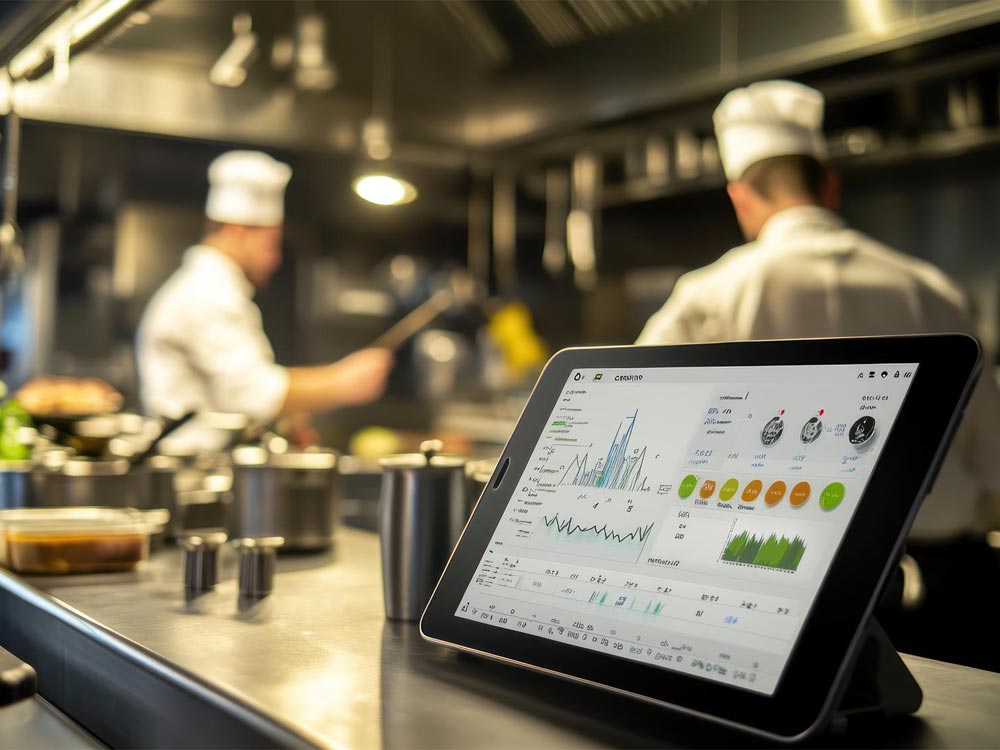Delivery robots and autonomous vehicles are fully or semi-autonomous small-sized delivery vehicles that travel on the roads and pavements to deliver food, retail items, beverages, and other goods. These robots and vehicles are controlled remotely via human operators and are an incredible option for last-mile deliveries.
a. What features do these robots have?
These autonomous vehicles utilize computer vision and satellite navigation systems to move and navigate. They have ultrasonic sensors, radars, and neural networks that prevent them from collisions. These delivery robots depend on machine learning algorithms to regulate movement and speed patterns on sidewalks. With the help of continuous learning, they generate a digital map for effective navigation and instant deliveries.
There are 2 common types of autonomous food delivery robots: group-based and aerial vehicles. Both offer features like GPS, cameras, and Light Detection and Ranging sensors to regulate their surroundings.
Let’s explore these features:
Self-driving robots are small but they are equipped with advanced technology. Most of the robot models offer a few key features:
1. Sensors and cameras
Both devices basically control the area around the robot to detect and avoid vehicles, people, and other obstacles nearby. For example, the autonomous robots by Starship Enterprises are equipped with nearly 12 cameras.
2. GPS
The GPS system has the ability to track the robot’s location. It assists in navigating the robot to the exact location.
3. Artificial intelligence (AI)
With the help of built-in AI, self-driving robots act autonomously. It gathers data from each system to detect crosswalks and traffic signals and optimize route decisions. All this is done without any human input.
4. Batteries
The self-driven robots are eco-friendly and efficient as they are battery-powered and easy to charge.
5. Security systems
These autonomous vehicles are highly secured, the robots lock automatically after loading the food. And they can be unlocked by the correct customer only.
The food delivery robots are equipped with insulated containers which:
- Keeps the food fresh at an appropriate temperature.
- The lid prevents the food from precipitation.
b. Food Delivery Robots and Restaurants:
When any restaurant opts for food delivery robots, the process is quite similar to that of a conventional delivery method. Here is how it’s done:
- The order is received by the kitchen display system of a restaurant.
- The staff packs the food, places it into the robot, and secures the lid with the lock.
- The most efficient route is selected by the robot and it delivers the food.
- The final step involves, the robot returning to its central hub or a restaurant.
These robots are not restricted by any road access. They simply move like a pedestrian along the sidewalk.
c. Food Delivery Robots and Customers:
If we talk about the customer’s end, food delivery robots add a unique touch of innovation to the food delivery process. On food delivery apps offering delivery robots, the experience is quick and simple:
- An order is placed on the app by the customer with a specified delivery location.
- Customers have the ability to track the order progress on the app.
- As soon as the robot departs with the customer’s order, the customer is updated.
- The robot is unlocked by the customer for food, via instructions given by the food delivery app.
As per the app protocols, customers have the ability to drop the pin location. This way robot reaches the right location, be it by the pool or outside the library.
Also explore how customer experience can be enhanced with food delivery apps:Enhancing Customer Experience with Food Delivery Apps: Features and Functionality

Let’s explore some popular examples of food delivery robots;
d. Examples of Autonomous Food Delivery Robots:
1. Starship Technologies Delivery Robot
The food delivery robot by Starship Technologies is known to be a state-of-the-delivery robot to delivers food from kitchens, restaurants, or storage facilities to the consumer’s doorstep without any prior human intervention.
The Starship food delivery robot is equipped with distinctive features including a battery-powered electric motor, autonomous driving system, cameras, and sensors, which help in navigating through complicated terrains, and are loyal towards traffic regulations.
Via this system:
- Customers can track their orders in real time via a mobile app.
- There is increased transparency and convenience.
- Have access to efficient route planning.
- Also, have access to a secured locked cargo to prevent food during delivery.

2. Foodpanda PandaBot
The Foodpanda PandaBot is another example of an autonomous delivery robot that is an ideal solution for urban settings. It can easily go through crowded areas and narrow streets. In this case, its efficient sensors that can detect and avoid obstacles, play a great role in ensuring the food is delivered safely.
The PandaBot is an exceptional option for small to medium-sized orders with a top speed of 15km/h for on-demand food services, delivering meals to customers in minutes.

e. The Pros and Cons of Food Delivery Robots
1. Sustainability
The food delivery robots are powered by electricity as a result of which they do not emit carbon dioxide or harmful pollutants, hence appearing to be a sustainable transport method. The use of such options enables companies to decrease carbon footprints without any compromise on the level of service.
2. Cost savings
Food delivery robots have emerged as a cost-effective option as compared to human delivery drivers since companies can save money being spent on expenses like wages and insurance. These cost savings are then passed over to the customers.
3. Improved Consistency
The food delivery robots can further improve the consistency and availability of delivery services, as they are programmed to abide by a set route for each delivery.
However, the other side of the picture addresses certain concerns related to food delivery robots;
4. Navigational Challenges
While promising convenience and efficiency, food delivery robots face certain obstacles in their operation and deployment. These vehicles often witness challenges in navigating complex urban environments such as uneven sidewalks, parked cars, and pedestrians, which can hinder their performance and lead to delivery failures.
5. Environmental Challenges
Adverse weather conditions like snow, fog, heavy rain, etc., can affect the functionality of these robots. Cameras and sensors may be affected due to poor visibility, making it a hassle for the robots to locate their surroundings. Moreover, power outages leave robots stranded on their way, leading to delays or disrupting the delivery service.
6. Human Replacement
Due to the emergence of food delivery robots, there are rising concerns about replacing human delivery drivers with them. This is yet not feasible but if implemented it will have serious implications on the employment level and morale of the people.
7. Speed
Food delivery robots are slow in speed of around 5mph as compared to their counterparts like delivery motorcycles and drones. They are a perfect deployment in corporate offices, educational campuses, and areas with wide sidewalks.
In most cases, delivery robots are unable to understand human interactions and are inflexible, therefore they require to be monitored remotely to prevent theft and vandalism issues.

Final words,
Delivery robots have proved themselves as a transformative solution in case of last-mile deliveries. Features like computer vision, satellite navigation, and machine learning prove these robots to be a promising asset. Although they have their own set of challenges like legal constraints, speed, recharging, etc. Despite these, the robots have appeared to be a cost-effective, sustainable, and efficient option. They have transformed the landscape of food logistics with their advanced technologies and improved performance.
Explore related links:
1. Enhancing Customer Experience with Food Delivery Apps: Features and Functionality
2. Software to Track and Reduce Inventory Waste in Restaurants.
.png)








